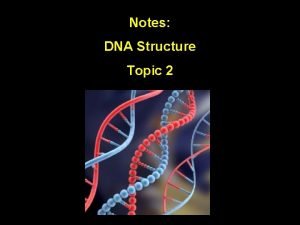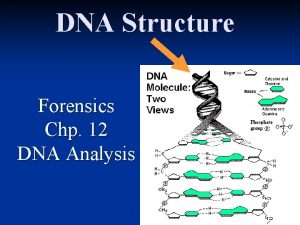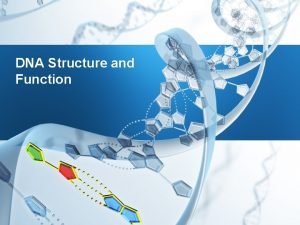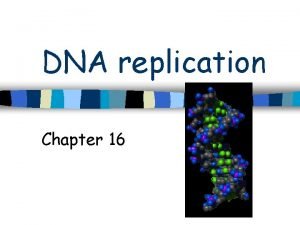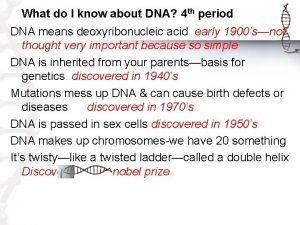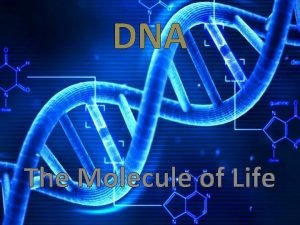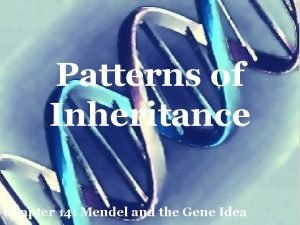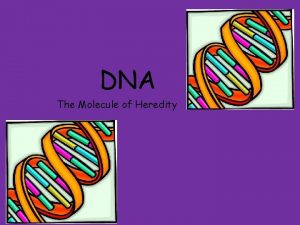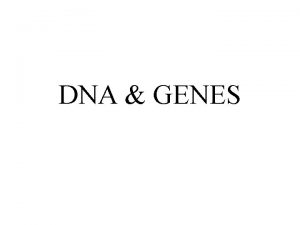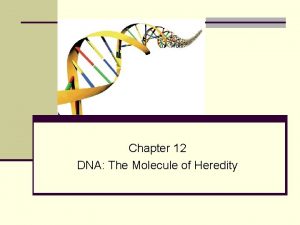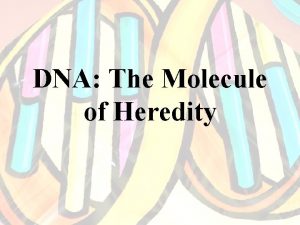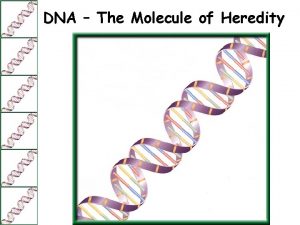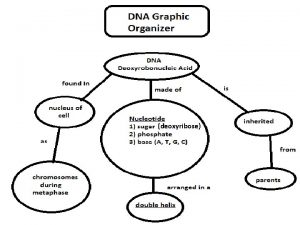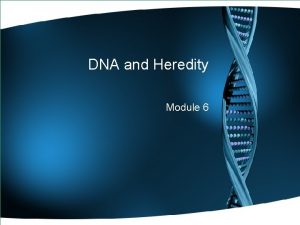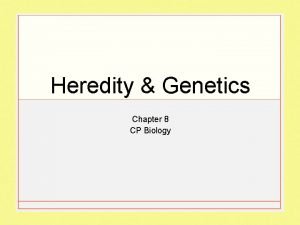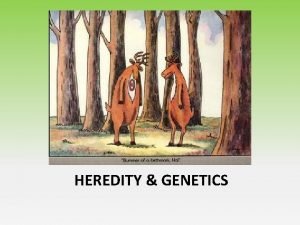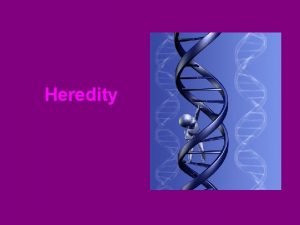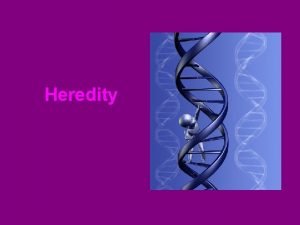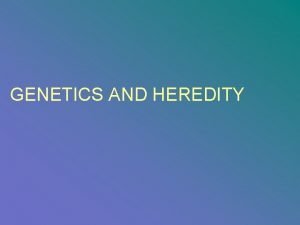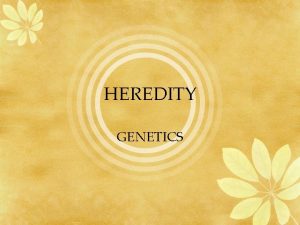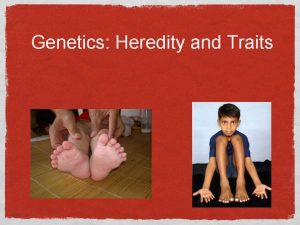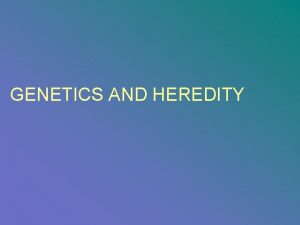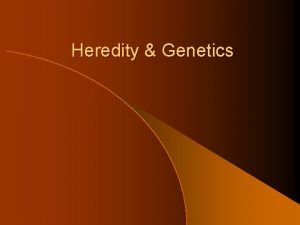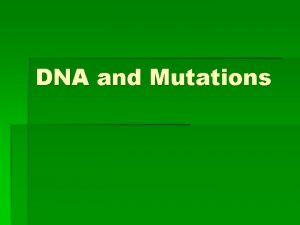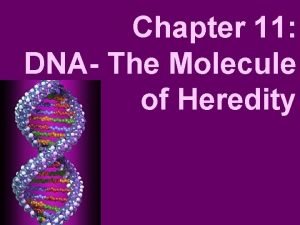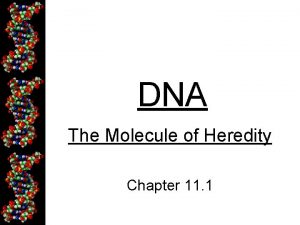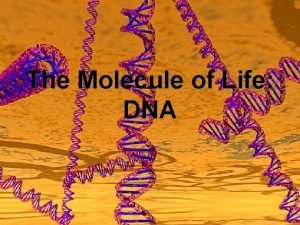Chapter 10 DNA The Molecule of Heredity Lectures


































- Slides: 34

Chapter 10 DNA: The Molecule of Heredity Lectures by Gregory Ahearn University of North Florida Copyright © 2009 Pearson Education, Inc.

10. 1 What Is The Structure Of DNA? § Deoxyribonucleic acid (DNA) is the blueprint of life. § DNA carries the information in its molecular structure, which codes for all the special features of a given life form. Copyright © 2009 Pearson Education Inc.

10. 1 What Is The Structure Of DNA? § Individual traits of an organism are transmitted from parent to offspring in discrete units of DNA called genes. § Genes are located on chromosomes found within the nucleus of cells. § What makes all organisms different from each other is the arrangement and molecular composition of its genes. Copyright © 2009 Pearson Education Inc.

10. 1 What Is The Structure Of DNA? § DNA is composed of four different subunits, called nucleotides. • Each nucleotide has three parts: • A phosphate group • A sugar, called deoxyribose • One of four different nitrogen-containing bases Copyright © 2009 Pearson Education Inc.

10. 1 What Is The Structure Of DNA? § DNA has four nitrogen-containing bases. • • Thymine Cytosine Adenine Guanine Copyright © 2009 Pearson Education Inc.

10. 1 What Is The Structure Of DNA? O O O– P –O phosphate CH 2 O H H H O– O phosphate CH 2 H H phosphate H O N OH H sugar Copyright © 2009 Pearson Education Inc. H O H H H O base = thymine N H base = guanine H O– H O phosphate H N H P –O N H OH H sugar O O N H CH 2 N O N H O N CH 3 P –O –O H base = adenine OH H sugar O N H P H N H O O– CH 2 H H N H H O N N H H O base = cytosine OH H sugar Fig. 10 -1

10. 1 What Is The Structure Of DNA? § A DNA molecule contains two nucleotide strands. • A DNA molecule consists of two DNA strands of linked nucleotides. • Within each strand, the phosphate group of one nucleotide binds to the sugar group of another nucleotide. • The sugar-phosphate bonding produces a sugar-phosphate backbone to the DNA molecule. Copyright © 2009 Pearson Education Inc.

10. 1 What Is The Structure Of DNA? § All the nucleotides in a single DNA strand are oriented in the same direction. • The ends of the two DNA strands are different. • One strand ends in an unbonded sugar. • One strand ends in an unbonded phosphate. Copyright © 2009 Pearson Education Inc.

10. 1 What Is The Structure Of DNA? § Hydrogen bonds hold the two DNA strands together in a double helix. • The two DNA strands are held together by hydrogen bonding between the protruding bases of the separate strands. • The combined strands of DNA form a ladderlike double helix, with a sugar-phosphate backbone and nucleotide pairs forming the rungs. Copyright © 2009 Pearson Education Inc.

10. 1 What Is The Structure Of DNA? § The Watson-Crick model of DNA structure nucleotide free phosphate base (cytosine) sugar free sugar (a) Hydrogen bonds hold complementary base pairs together in DNA Copyright © 2009 Pearson Education Inc. (b) Two DNA strands form a double helix (c) Four turns of a DNA double helix Fig. 10 -2

10. 1 What Is The Structure Of DNA? § Nucleotide rungs only result in specific pair combinations. • Adenine only pairs with thymine. • Guanine only pairs with cytosine. • These A–T and G–C pairs are called complementary base pairs. Copyright © 2009 Pearson Education Inc.

10. 1 What Is The Structure Of DNA? PLAY Animation—DNA Structure Copyright © 2009 Pearson Education Inc.

10. 2 How Does DNA Encode Information? § It is NOT the number of different subunits that code for all the diversity of characteristics among organisms, but it is rather the sequence in which they are arranged along the molecule. § Within a DNA molecule, the bases can be arranged in any sequence. § Each sequence is a unique set of genetic instructions. Copyright © 2009 Pearson Education Inc.

10. 2 How Does DNA Encode Information? § A stretch of DNA only 10 nucleotides long can have more than 1 million possible sequences of the four bases. § Since a typical organism has millions (e. g. , a bacterium) or billions (e. g. , a plant or animal) of nucleotides, DNA molecules can encode an incredible amount of information. Copyright © 2009 Pearson Education Inc.

10. 3 How Is DNA Copied? § Cells reproduce themselves by making two daughter cells from each parental cell, each with a complete copy of all the parental cell’s genetic information. § During cell reproduction, the parental cell synthesizes two exact copies of its DNA through a process called DNA replication. § One copy goes into each daughter cell. Copyright © 2009 Pearson Education Inc.

10. 3 How Is DNA Copied? § DNA replication produces two DNA double helices, each with one original strand one new strand. • DNA replication requires three ingredients: • The parental DNA strands • Free nucleotides that were synthesized in the cytoplasm and then imported to the nucleus • A variety of enzymes that unwind the parental DNA double helix and synthesize new DNA strands Copyright © 2009 Pearson Education Inc.

10. 3 How Is DNA Copied? § The basic features of DNA replication 1 Parental DNA double helix 2 The parental DNA is unwound 3 New DNA strands are synthesized with bases complementary to the parental strands free nucleotides 4 Each new double helix is composed of one parental strand (blue) and one new strand (red) Copyright © 2009 Pearson Education Inc. Fig. 10 -3

10. 3 How Is DNA Copied? § DNA replication produces two DNA double helices, each with one original strand one new strand (continued). • The first step involves enzymes called DNA helicases, which pull apart the parental DNA double helix. • Next, enzymes called DNA polymerases move along each separated parental DNA strand, matching each base on the strand with free nucleotides. Copyright © 2009 Pearson Education Inc.

10. 3 How Is DNA Copied? § DNA replication keeps, or conserves, one parental DNA strand produces one new daughter strand. • This process is called semiconservative replication. Copyright © 2009 Pearson Education Inc.

10. 3 How Is DNA Copied? § DNA replication is semiconservative. One DNA double helix DNA replication Two identical DNA double helices, each with one parental strand (blue) and one new strand (red) Copyright © 2009 Pearson Education Inc. Fig. 10 -4

10. 4 What Are The Mechanisms Of DNA Replication? § DNA helicase separates the parental DNA strands by breaking the hydrogen bonds between complementary bases. • This activity separates the two strands and forms a replication bubble where the parental strands are no longer paired. • Replication then proceeds. Copyright © 2009 Pearson Education Inc.

10. 4 What Are The Mechanisms Of DNA Replication? § The mechanism of DNA replication, step (1) replication bubbles DNA Copyright © 2009 Pearson Education Inc. Fig. 10 -5(1)

10. 4 What Are The Mechanisms Of DNA Replication? § DNA helicase separates the parental DNA strands. • There is a replication fork on each end of the bubble, where replication is taking place and the original DNA strand is unzipping. • The unzipping and replication continues in both directions until the new strands are completely formed. Copyright © 2009 Pearson Education Inc.

10. 4 What Are The Mechanisms Of DNA Replication? § The mechanism of DNA replication, step (2) DNA helicase replication forks Copyright © 2009 Pearson Education Inc. Fig. 10 -5(2)

10. 4 What Are The Mechanisms Of DNA Replication? § DNA polymerase synthesizes new DNA strands. • At the replication forks, DNA polymerase recognizes unpaired nucleotide bases in the parental strand matches them up with free nucleotides. • It then links up the phosphate of the incoming nucleotide with the sugar of the previously added nucleotide, thereby contributing to the growing molecule backbone. Copyright © 2009 Pearson Education Inc.

10. 4 What Are The Mechanisms Of DNA Replication? § DNA helicase and DNA polymerase work together to copy each strand of separated parental DNA. • Polymerase # 1 lands on one strand of DNA and follows behind the helicase toward the free phosphate end of the DNA, making a continuous new DNA strand. • DNA polymerase # 2 on the other parental strand moves away from the helicase and makes only part of the new DNA strand. Copyright © 2009 Pearson Education Inc.

10. 4 What Are The Mechanisms Of DNA Replication? § The mechanism of DNA replication, step (3) DNA polymerase #1 free sugar end of the parental DNA polymerase #2 Copyright © 2009 Pearson Education Inc. free phosphate end of the parental DNA strand Fig. 10 -5(3)

10. 4 What Are The Mechanisms Of DNA Replication? § As the helicase continues to unwind more of the double helix, additional DNA polymerase (# 3, # 4, etc. ) must land on this strand to synthesize more pieces of DNA. § Therefore, DNA synthesis on the second parental strand is discontinuous. Copyright © 2009 Pearson Education Inc.

10. 4 What Are The Mechanisms Of DNA Replication? § The mechanism of DNA replication, step (4) DNA polymerase #1 continues along the parental DNA strand DNA polymerase #2 leaves DNA polymerase #3 Copyright © 2009 Pearson Education Inc. Fig. 10 -5(4)

10. 4 What Are The Mechanisms Of DNA Replication? § Multiple DNA polymerases make many pieces of DNA of varying lengths that need to be tied together to form a single continuous DNA polymer. § DNA ligase joins together the separate segments of DNA. Copyright © 2009 Pearson Education Inc.

10. 4 What Are The Mechanisms Of DNA Replication? § The mechanism of DNA replication, step (5) DNA polymerase #3 leaves DNA polymerase #4 Copyright © 2009 Pearson Education Inc. DNA ligase joins the daughter DNA strands together Fig. 10 -5(5)

10. 4 What Are The Mechanisms Of DNA Replication? PLAY Animation—DNA Replication Copyright © 2009 Pearson Education Inc.

10. 4 What Are The Mechanisms Of DNA Replication? § Proofreading produces almost error-free replication of DNA. • DNA polymerase is almost 100% perfect in matching free nucleotides with those on the original parental strands. • Once in every 10, 000 base pairs, there is an error in replication. • Some types of DNA polymerase recognize errors when they are made and correct them. • This keeps the total errors in a complete DNA molecule to one mistake in every billion base pairs. Copyright © 2009 Pearson Education Inc.

10. 4 What Are The Mechanisms Of DNA Replication? § Mistakes that remain in the DNA nucleotide sequence are called mutations. Copyright © 2009 Pearson Education Inc.
 Dna structure labeled diagram
Dna structure labeled diagram Dna molecule two views
Dna molecule two views Label the parts of the dna molecule.
Label the parts of the dna molecule. Phosphodiester bond in dna
Phosphodiester bond in dna Dna prokaryotic
Dna prokaryotic Structure of dna
Structure of dna Monomer of dna
Monomer of dna The molecule dna contains the four bases listed below.
The molecule dna contains the four bases listed below. Dna the molecule of life
Dna the molecule of life Chapter 11 human heredity section 11-3
Chapter 11 human heredity section 11-3 Chapter 11 complex inheritance and human heredity test
Chapter 11 complex inheritance and human heredity test Extra x
Extra x Dice and coin
Dice and coin Chapter 17 lesson 2 heredity and genetics
Chapter 17 lesson 2 heredity and genetics Dna polymerase function in dna replication
Dna polymerase function in dna replication Bioflix activity dna replication dna replication diagram
Bioflix activity dna replication dna replication diagram Coding dna and non coding dna
Coding dna and non coding dna Replication process
Replication process Chapter 11 dna and genes
Chapter 11 dna and genes Rick trebino lectures
Rick trebino lectures Neonatology lectures
Neonatology lectures Data mining lectures
Data mining lectures Advanced medicinal chemistry
Advanced medicinal chemistry Uva powerpoint template
Uva powerpoint template Cs614 short lectures
Cs614 short lectures Activity planning software project management
Activity planning software project management Cell and molecular biology lectures
Cell and molecular biology lectures Radio astronomy lectures
Radio astronomy lectures Dr sohail lectures
Dr sohail lectures Utilities and energy lectures
Utilities and energy lectures Web engineering lectures ppt
Web engineering lectures ppt Do words have power
Do words have power Frcr physics lectures
Frcr physics lectures Frcr physics lectures
Frcr physics lectures Introduction to recursion
Introduction to recursion
